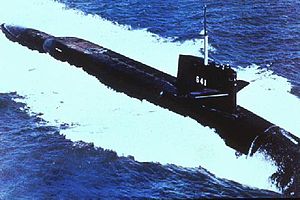USS Simon Bolivar (SSBN-641)

USS Simon Bolivar (SSBN-641) on 1 February 1991
|
|
| History | |
|---|---|
| Namesake: | Simón Bolívar (1783–1830), a hero of South American independence movements |
| Awarded: | 1 November 1962 |
| Builder: | Newport News Shipbuilding, Newport News, Virginia |
| Laid down: | 17 April 1963 |
| Launched: | 22 August 1964 |
| Sponsored by: | Mrs. Thomas C. Mann |
| Commissioned: | 29 October 1965 |
| Decommissioned: | 8 February 1995 |
| Struck: | 8 February 1995 |
| Honors and awards: |
|
| Fate: | Scrapping via Ship and Submarine Recycling Program begun 1 October 1994; completed 1 December 1995 |
| General characteristics | |
| Class and type: | Benjamin Franklin class nuclear-powered ballistic missile submarine |
| Displacement: | 6,494 tons |
| Length: | 425 feet (130 m) |
| Beam: | 33 feet (10 m) |
| Draft: | 32 feet (9.8 m) |
| Propulsion: | S5W reactor |
| Speed: |
|
| Test depth: | 1,300 feet (400 m) |
| Complement: | Two crews (Blue Crew and Gold Crew) of 14 officers and 126 enlisted men each |
| Armament: |
|
USS Simon Bolivar (SSBN-641), a Benjamin Franklin class fleet ballistic missile submarine, was the only ship of the United States Navy to be named for Simón Bolívar (1783–1830), a hero of the independence movements of the former Spanish colonies in South America.
Simon Bolivar's keel was laid down on 17 April 1963 by the Newport News Shipbuilding of Newport News, Virginia. She was launched on 22 August 1964, sponsored by Mrs. Thomas C. Mann, and commissioned on 29 October 1965 with Commander Charles H. Griffiths commanding the Blue Crew and Commander Charles A. Orem commanding the Gold Crew.
During late December 1965 and most of January 1966, Simon Bolivar underwent demonstration and shakedown operations. The Gold Crew successfully fired a Polaris A-3 ballistic missile off the coast of Cape Kennedy, Florida, on 17 January 1966, and the Blue Crew completed a successful Polaris missile firing on 31 January.
The Gold Crew continued shakedown operations in the Caribbean Sea in February. The following month, Simon Bolivar's home port was changed to Charleston, South Carolina, where she was assigned to Submarine Squadron 18, and minor deficiencies were corrected during a shipyard availability period.
In April 1966 Simon Bolivar got underway and went to alert status for the first of more than 70 strategic deterrent patrols spanning four decades and three major submarine launched ballistic missile weapons systems (Polaris, Poseidon, Trident).
...
Wikipedia
